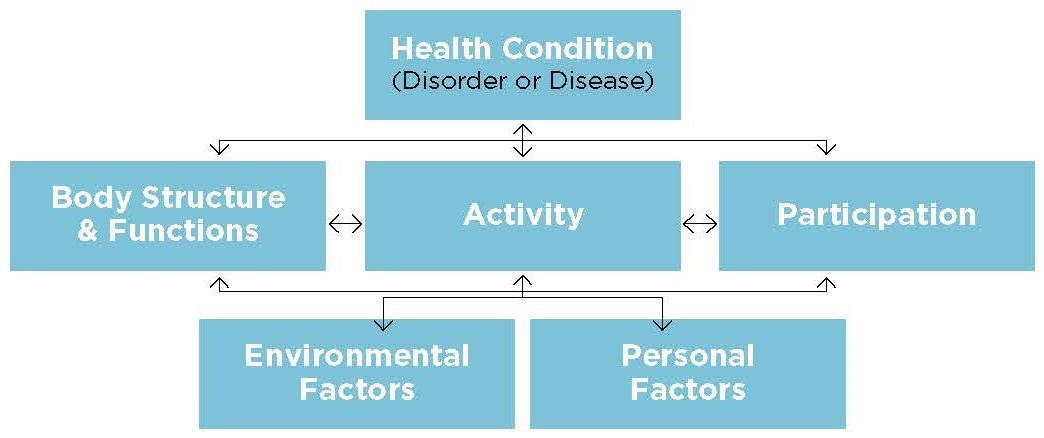Principle 1: Measure and demonstrate the effectiveness of treatment
Key messages
- Treatment should result in a measurable benefit to the injured person.
- Relevant aspects of the person’s health status that are expected to change with treatment should be measured (such as pain, depression, activities of daily living, health-related quality of life and work performance).
- When available, outcome measures that are reliable, valid and sensitive to change should be used.
- Outcome measures must be related to the functional goals of therapy, relevant to the person’s injury, and address the components of the World Health Organisation International Classification of Functioning, Disability and Health.
Why measure
A health outcome is the impact of an intervention on a person’s health.1 The measurement of treatment effectiveness (or outcome):
- provides injured people, treating healthcare professionals, and other decision makers with information on the rate (and direction) of change (e.g. is the person’s health status improving, worsening or not changing?)
- empowers an injured person to track and monitor their progress or any changes in their status
- informs and justifies decisions to continue, change or cease treatment, or refer the injured person to another healthcare professional or service
- provides useful information that can assist in targeting treatment and help improve treatment outcomes.
How to measure
Treatment effectiveness should be measured with standardised outcome measurement tools that are reliable, valid and sensitive to change. This is a robust way to gauge an injured person’s health status. Standardised outcome measures may be supplemented with customised measures of aspects of health or function that are relevant to the injured person and their status. However, as the reliability, validity and responsiveness of customised outcome measures are generally not known, these should only be used when there is no suitable standardised measure available, or in addition to a standardised measure.
The following are examples of customised outcome measures that can demonstrate the effectiveness of an intervention:
- a change in work status – a person who was off work starts to return to work or there is a change in their work capacity. For example, an increase in hours at work, progress from sitting for 10 minutes to 30 minutes, or a move from modified to normal duties.
- a change in participation at home – measurable improvement with specific household tasks. For example, going from vacuuming one room in a day to vacuuming three rooms in a day.
When to measure
Baseline outcome measurements should be taken as soon as possible and repeated regularly to review progress. Reassessment should occur as soon as change could be reasonably expected given the injured person’s injury, prognosis, and the type of treatment provided. During the acute phase, when rapid change may be expected, reassessment may occur as often as weekly, or even within a session.
The regular measurement of outcomes provides ongoing information about the injured person’s health status and the effectiveness of the intervention. This process plays an integral role in justifying the healthcare professional’s management plan. It also helps to inform the injured person about their progress, recovery and independence.
What to measure
Outcome measures must be related to the functional goals of therapy and relevant to the person’s injury. They should also address the participation, activity and body structures and function components of the World Health Organization International Classification of Functioning, Disability and Health.2 The ICF provides a clear description of health and health-related states to promote effective communication between healthcare professionals.
Figure 1: Interactions between the components of ICF

The table below provides a description of the components of the ICF and their measurement principles, including their specific impact on health and functioning. Some outcome measurement tools cover more than one component of the ICF.
Table 1: Components of the ICF
| ICF component | Definition | Impact on health and functioning | Measurement principles |
|---|---|---|---|
| Body functions and body structures | Body functions are the physiological and psychological functions of the body. Body structures are anatomical parts of the body such as organs and limbs. | Problems in body functions and body structures result in impairments such as pain, altered mood, restricted range of joint motion, swelling, ligament tear. | Measures of impairments should not be used in isolation since impairments do not necessarily indicate how the injury is affecting the injured person’s function, behaviour and return to work. |
| Activity | Activity is the execution of a task or action, such as walking, driving or cleaning. | Activity limitations are difficulties a person may have in performing activities. | Measures of activity present a clear picture of progress in function, change in behaviour and work. |
| Participation | Participation is involvement in a life situation such as work. | Participation restrictions are problems a person may have in taking part in life situations. | Measures of participation present a clear picture of progress at home, work and in the community. |
| Personal and environmental factors | Personal factors are internal influences such as beliefs, self efficacy and ways of coping. Environmental factors make up the physical, social and attitudinal environment in which people live their lives. | Personal factors refer to the impact of the person’s attributes on their health and functioning. Environmental factors are features of physical, social and attitudinal surroundings that can facilitate or hinder health and functioning. | Measures of personal and environmental factors should be used to: (i) identify potential risk factors for the development of persistent pain or long-term disability (ii) evaluate progress and outcomes. |
References
1. Australian Health Ministers’ Advisory Council 1993. ‘AHMAC Sunshine Statement’, Proceedings of the AHMAC Health Outcomes Seminar, AHMAC, Sunshine Victoria.
2. World Health Organization 2001, International Classification of Functioning, Disability and Health, World Health Organization, Geneva.

